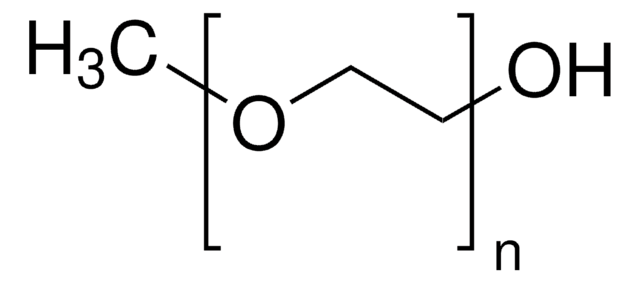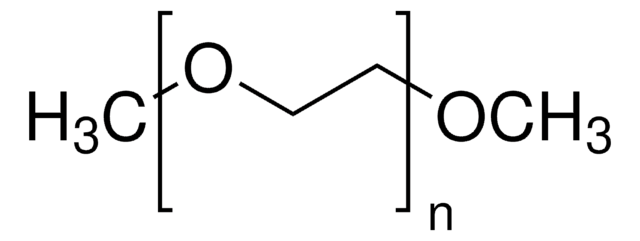Wichtige Dokumente
71578
Poly(ethylenglycol)methylether
BioUltra, 500
Synonym(e):
Methoxy-polyethylenglykol, Polyethylenglykol-monomethylether, mPEG
About This Item
Empfohlene Produkte
Dampfdichte
>1 (vs air)
Qualitätsniveau
Dampfdruck
0.05 mmHg ( 20 °C)
Beschreibung
non-ionic
Produktlinie
BioUltra
Form
paste
viscous liquid (clear)
Mol-Gew.
470-530
Verunreinigungen
insoluble matters, passes filter test
≤0.005% peroxides (as H2O2)
pH-Wert
5.5-7.0 (25 °C, 50 mg/mL in H2O)
mp (Schmelzpunkt)
20 °C (lit.)
Löslichkeit
H2O: 50 mg/mL at 25 °C, clear, colorless
Anionenspuren
chloride (Cl-): ≤50 mg/kg
sulfate (SO42-): ≤50 mg/kg
Kationenspuren
Al: ≤5 mg/kg
As: ≤0.1 mg/kg
Ba: ≤5 mg/kg
Bi: ≤5 mg/kg
Ca: ≤10 mg/kg
Cd: ≤5 mg/kg
Co: ≤5 mg/kg
Cr: ≤5 mg/kg
Cu: ≤5 mg/kg
Fe: ≤5 mg/kg
K: ≤200 mg/kg
Li: ≤5 mg/kg
Mg: ≤5 mg/kg
Mn: ≤5 mg/kg
Mo: ≤5 mg/kg
Na: ≤200 mg/kg
Ni: ≤5 mg/kg
Pb: ≤5 mg/kg
Sr: ≤5 mg/kg
Zn: ≤5 mg/kg
λ
50 mg/mL in H2O
UV-Absorption
λ: 260 nm Amax: 0.06
λ: 280 nm Amax: 0.03
Funktionelle Gruppe
hydroxyl
InChI
1S/C3H8O2/c1-5-3-2-4/h4H,2-3H2,1H3
InChIKey
XNWFRZJHXBZDAG-UHFFFAOYSA-N
Suchen Sie nach ähnlichen Produkten? Aufrufen Leitfaden zum Produktvergleich
Sie haben nicht das passende Produkt gefunden?
Probieren Sie unser Produkt-Auswahlhilfe. aus.
Lagerklassenschlüssel
10 - Combustible liquids
WGK
WGK 1
Flammpunkt (°F)
359.6 °F - closed cup
Flammpunkt (°C)
182 °C - closed cup
Persönliche Schutzausrüstung
Eyeshields, Gloves
Hier finden Sie alle aktuellen Versionen:
Besitzen Sie dieses Produkt bereits?
In der Dokumentenbibliothek finden Sie die Dokumentation zu den Produkten, die Sie kürzlich erworben haben.
Kunden haben sich ebenfalls angesehen
Unser Team von Wissenschaftlern verfügt über Erfahrung in allen Forschungsbereichen einschließlich Life Science, Materialwissenschaften, chemischer Synthese, Chromatographie, Analytik und vielen mehr..
Setzen Sie sich mit dem technischen Dienst in Verbindung.



